North America is home to approximately four thousand bee species, of which more than eight hundred have been identified in Texas.
Being insects, bees have a body that is divided into the head, thorax and abdomen. Only females can sting. The majority of black and yellow, though they come in a range of colors from blue or red to black and green. Some are striped and others have a metallic sheen.
We have listed the most common bees you may encounter in Texas, from the most popular to the least popular.
Table of Contents
1. Western Honey Bee
Western honey bees (Apis mellifera) are also known as European honey bees. They are distributed throughout the world. These bees create colonies, which include one fertile female, known as the queen.
A single colony can be home to thousands of bees. This is one of the first domestic species and is very common with beekeepers for their honey production and pollination abilities.
The bees are red/brown in color with black banding and orange/yellow rings on the abdomen. There is hair on the thorax and abdomen. They have a pollen basket on their hind legs with dark brown to black legs.
2. American Bumble Bee
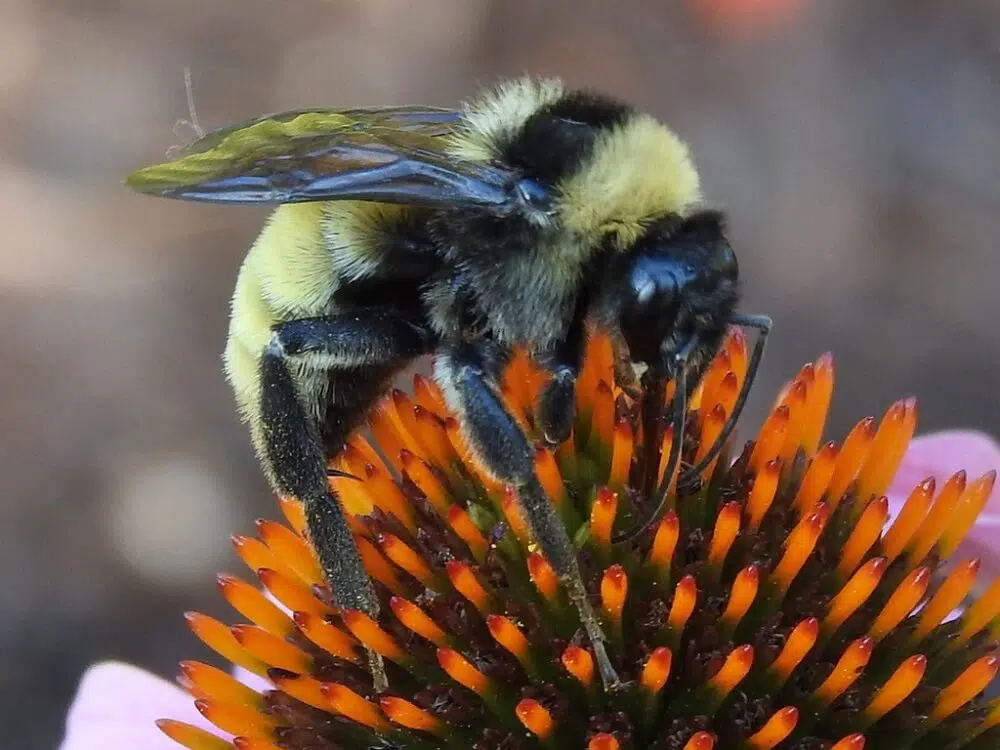
The American bumblebee (Bombus pensylvanicus) is a threatened species native to North America. They were once the most common bumblebee in the southern United States, but their populations are decreasing. The population has dropped by almost ninety percent in the past twenty years.
These bees prefer fields and open farmlands where they favor sunflowers. These bumblebees have a yellow thoracic dorsum with black posttrial. They have alternating black and white segments with short hair.
The queen can grow to 26mm in body length, while workers grow to around 19mm in body length. These bees are known to travel up to 1.5 miles in search of food.
3. Eastern Carpenter Bee

The Eastern carpenter bee (Xylocopa virginica) is common in Texas, nesting in various wooded areas, eating pollen and nectar. These bees are around the same size as bumblebees. They are glossy black with a slight purple color.
The male has a longer body, while the females have a wider head.
4. Southern Carpenter Bee
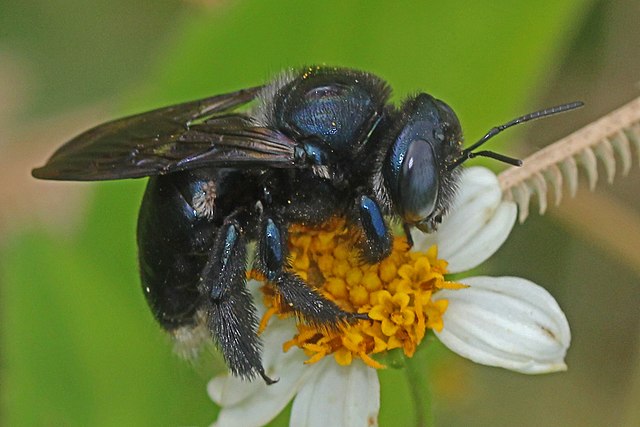
The Southern Carpenter Bee (Xylocopa micans) is often found near woody plants. These bees do not live in colonies. These are large bees growing to 19mm in body length, with black metallic coloration, which reflects as green or blue.
They create nests by excavating wooded plant material, including deadwood. You will probably never see their nests in nature. The female vibrates holes in the wood, burrowing a nest of around 12cm in length.
5. Ligated Furrow Bee
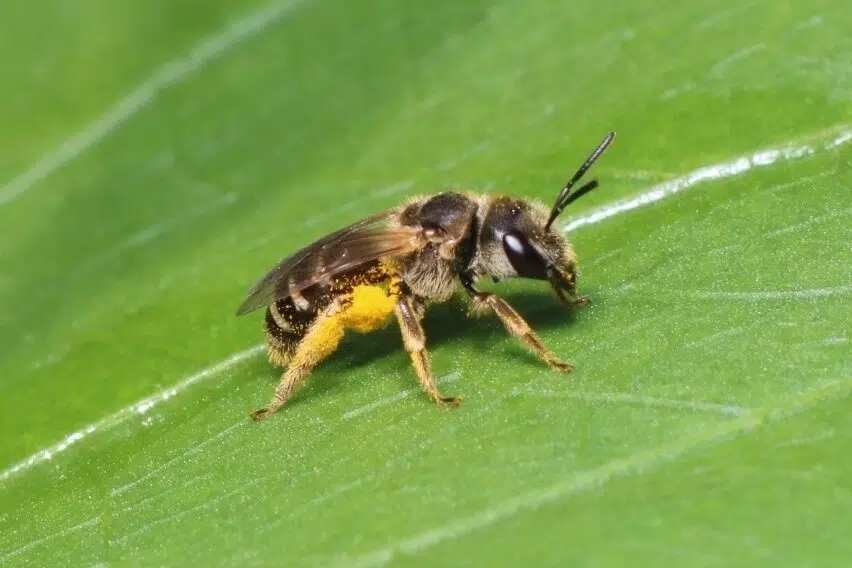
The Ligated Furrow Bee (Halictus ligatus) is a burrowing bee, that creates a nest underground. These bees are predominantly black or brown/black.
Females differ in size, based on reproductive strategies. Queens are larger-bodied, while helpers are smaller-bodied with undeveloped ovaries.
6. Horse-fly Carpenter
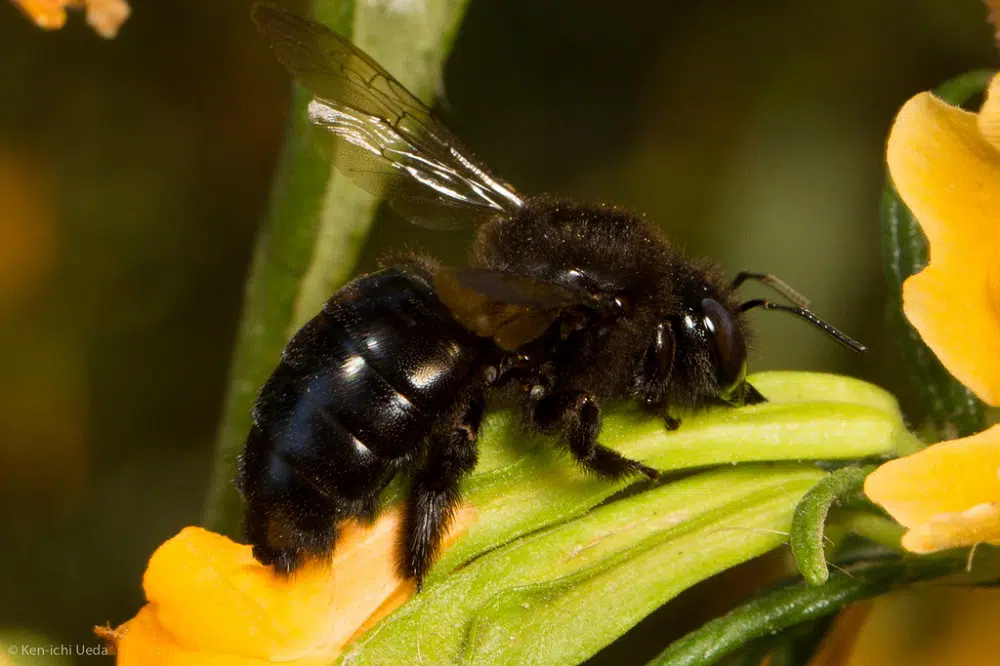
The Horse Fly Carpenter Bee (Xylocopa tabaniformis) is common in North America and is an essential pollinator for pepper, tomato, and eggplants. Tomato plants require the pollinating skill these bees possess.
These bees are predominantly black with a metallic green or blue coloration.
7. Sonoran Bumble Bee

The Sonoran Bumble Bee (Bombus sonorus) is a large and colorful bee that is native to the Sonoran desert and the western United States. The worker bees grow to 18mm in length with the queen being slightly larger.
This is one of the most common and widespread bumblebees in North America. They have black heads with the front and back of the thorax being yellow. There is a black band between the wings and the abdomen is yellow with the last three segments being black.
Juveniles have brilliant yellow body hairs. They visit a range of flowers including sunflowers, clover, and thistles.
8. Two-spotted Longhorn Bee

The Two-spotted Longhorn Bee (Melissodes bimaculatus) has two light spots at the end of the abdomen, which stand out against the black body. The males have long antennae. The legs have yellow hairs, which often look like pollen dust at first glance.
These are common bees in the spring and summer, often seen collecting pollen from flowers in agricultural fields. Even though they are common, very little research has been carried out on this bee species.
9. Metallic Epauletted-Sweat Bee
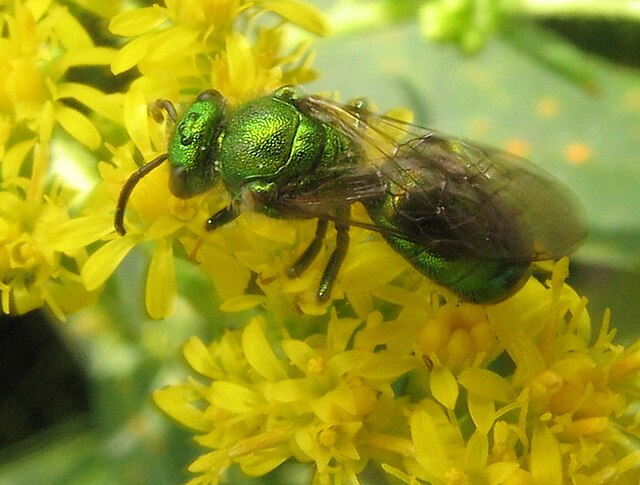
The Metallic Epauletted-Sweat Bee (Augochloropsis metallica) is a distinctive green color with a bean shape. They grow to around 9mm in body length. These are common in Texas from March to November where they visit a range of flowers.
10. Strand’s Carpenter Bee
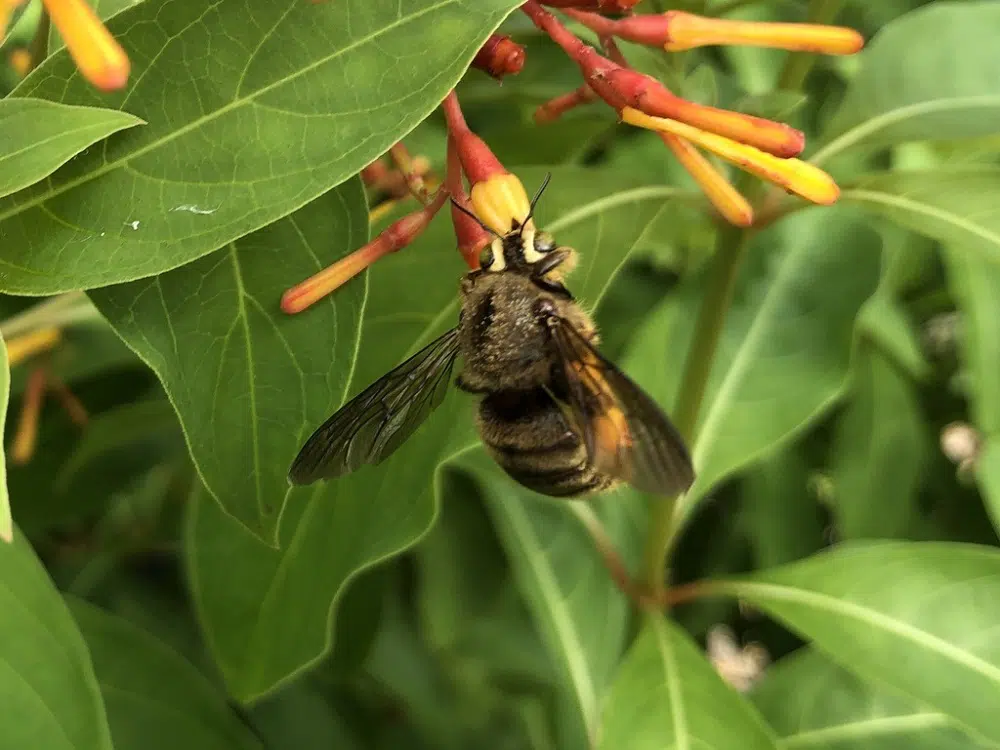
The Strand’s Carpenter Bee (Xylocopa strandi) is a large carpenter bee, building a nest in wood. They use their strong mandibles to create circular holes.
These bees are large bees, growing to around 20mm in body length, resembling bumblebees. The carpenter bee is shiny and black, with metallic blue, green, or purple/blue coloration. There is pale yellow on the thorax, abdomen, and legs.
11. Carpenter-mimic Leafcutter Bee

The Carpenter-mimic Leafcutter Bee (Megachile xylocopoides) is common in Texas with a stable population. This bee looks different from the other native species, it is larger but smaller than the carpenter bee.
These bees have a distinctive bulky appearance and are black and shiny, making them eye-catching. Males have white hairs on their thorax and head. These are solitary bees, with each female building and provisioning her own nests.
Unlike other bees, the carpenter-mimic leafcutter bee carries the pollen under the abdomen, rather than on its legs. Females gather the pollen from sunflowers, goldenrods, daisies, and asters, to name a few.
12. Oblique Longhorn
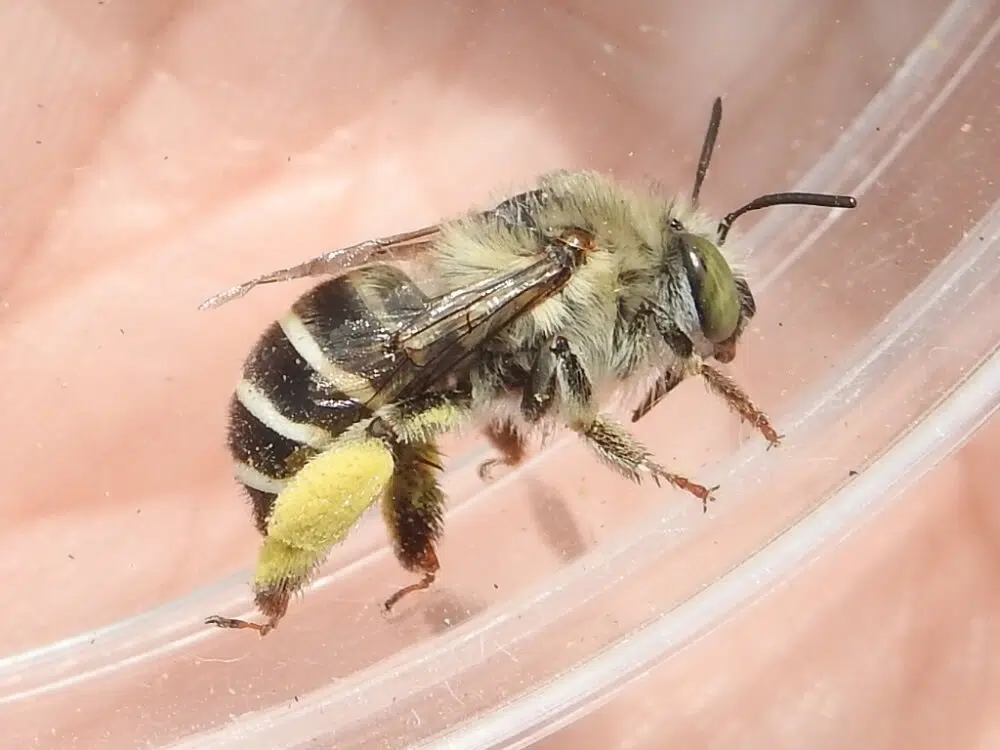
The Oblique Longhorn (Svastra obliqua) is a large, shaggy bee, known for its preference for sunflowers. They usually come out late in the summer or fall. The bees nest in the ground and are solitary, though their nests may be close to each other.
Some females are known to share nests, each bee provisioning her own egg chamber. They are often called the sunflower bee and are found in Texas and other parts of the United States, they are essential sunflower pollinators.
13. Megachile policaris

The Megachile policaris is a solitary and non-metallic bee. They are black bees where females take nectar and pollen to create a nest where she deposits an egg. Females will fill the nest with eggs, creating a thick wall around the nest, made of leaves.
Their nests are created in wood and soil. They have a weak sting and do not produce honey.
14. Mexican Carpenter Bee

Mexican Carpenter Bees (Xylocopa mexicanorum) are black bees with dark wings, they have a blue shimmering highlight. While females are completely black, males have white banded hairs on their abdomens.
The males are very territorial, though they do not form colonies and are known to winter in old nests.
15. Blueberry Mason Bee

The Blueberry Mason Bee (Osmia ribifloris) is native to North America, including Texas. This is a solitary bee that gathers pollen from plants and is known to pollinate blueberries.
The name mason bee comes from their constructing nests using mud and masonry products, which are made in gaps such as dark cavities and cracks in stones. They are mostly active from early spring to late summer.
They are often a metallic blue to green color, though some are black and others have some rusty red coloration. They are often used by farmers to facilities efficient pollination on farms.
16. Valley Carpenter Bee

The Valley Carpenter Bee (Xylocopa sonorina) is common in Western Texas. Females are black, while the males are golden brown with green eyes. They are large bees that can grow to 2.5cm in body length.
Females have a black head and thorax and a shiny abdomen, which is entirely black. They are not an aggressive species and will only sting if provoked. Males do not have stingers.
17. Common Eastern Bumble Bee

The Common Eastern Bumble Bee (Bombus impatiens) is a common bee in Texas and is adaptable, living in rural areas and urban cities.
These bees have short hair, medium-sized heads, and a long, rectangular-shaped body. The queen can grow to 23mm, while workers grow to 16mm in body length. Queens and workers are black with a yellow thorax and the first abdominal segment in yellow. Males also have a yellow head and face.
18. Brown-belted Bumble Bee

The Brown-belted Bumble Bee (Bombus griseocollis) is native to the United States, though it is not common in the southwest. Queens grow to 2.3cm in body length with a black face and head with yellow hairs. Their thorax is yellow, while the abdomen is yellow with black banding.
The female workers barely grow to 1cm in length and are similar in color, though they often have a yellow/brown colored band on the abdomen. Males have yellow hairs on their face and thorax with a banded brown, black and yellow abdomen.
19. Brown-winged Striped Sweat Bee

The Brown-winged Striped Sweat Bee (Agapostemon splendens) is a metallic blue-green bee with dark banding. Males have yellow and black banding on the abdomen. They are attracted to perspiration.
These bees grow to around 13mm in body length. They can sting but are not aggressive. They are ground-nesting and solitary bees that are great pollinators of native wildflowers.
20. Flat-tailed Leaf-cutter Bee
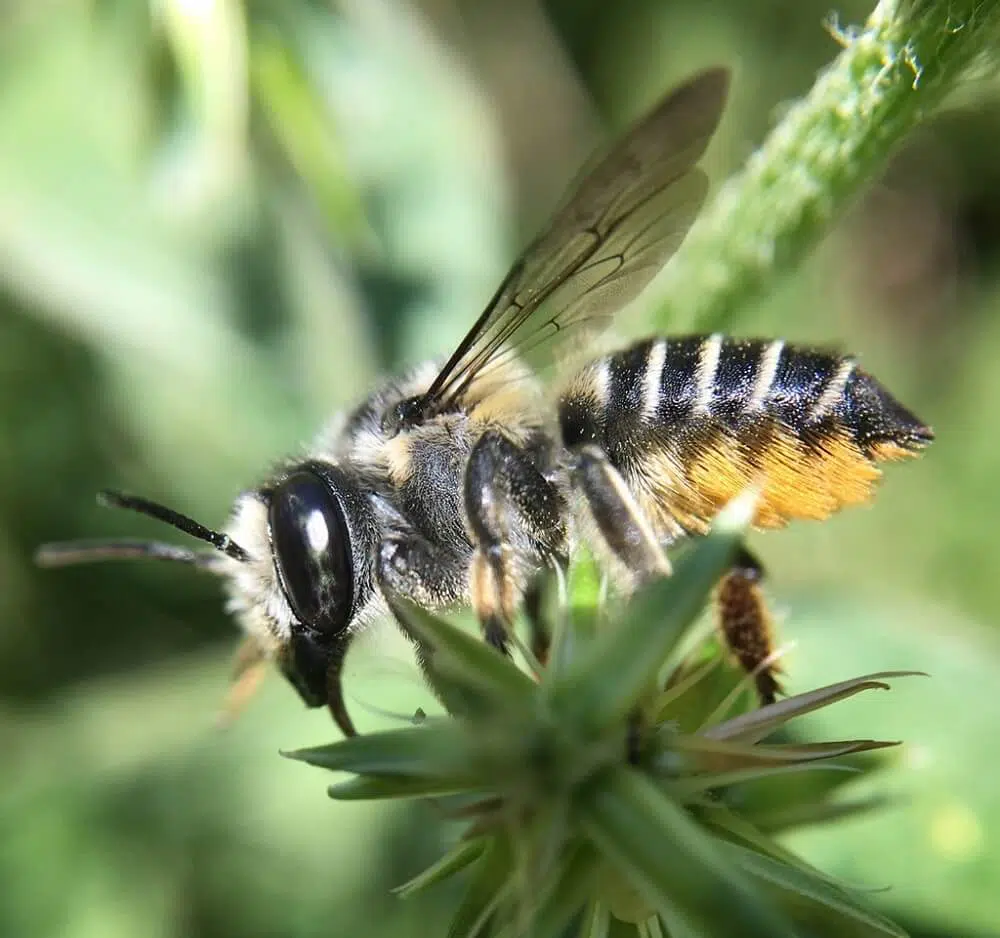
The Flat-tailed Leaf-cutter Bee (Megachile mendica) is known for visiting flat top goldentop, treacle, mustard, and other plants. These bees can grow to 8.5mm in body length. They tend to be black and dark gray.
This is not an aggressive species and usually will only sting if provoked.
21. Tripartite Sweat Bee
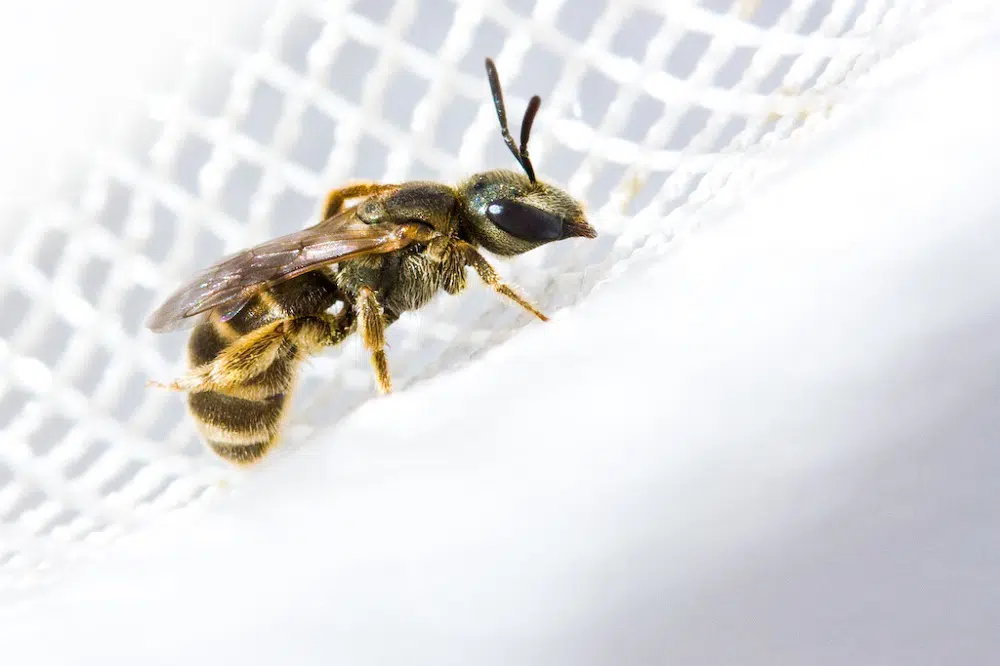
The Tripartite Sweat Bee (Halictus tripartitus) is a metallic green color and is common in Texas from February to October. They visit flowers and are known as excellent pollinators.
The name sweat bee is due to the fact that these bees are attracted to perspiration. Their stings are very mild and only used when provoked.
22. California Digger Bee
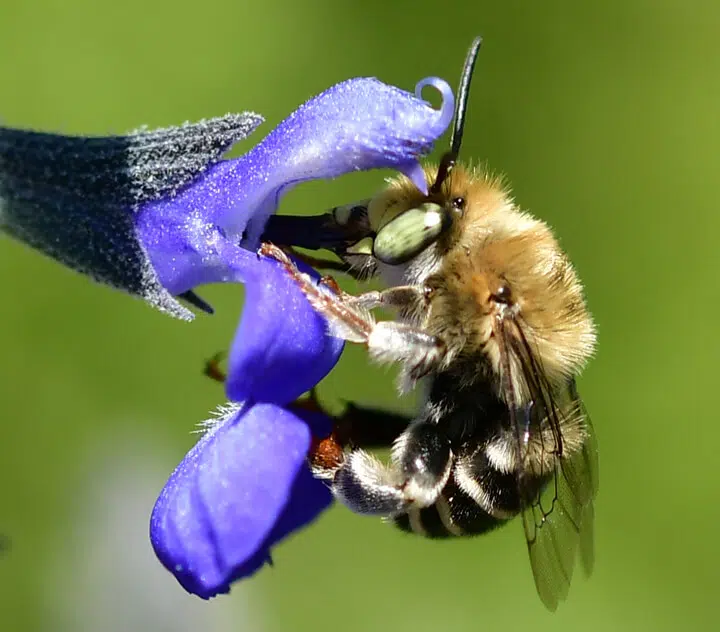
The California Digger Bee (Anthophora californica) is a noisy insect. They move quickly between flowers, hovering in front of them, while pushing their faces into the flower, covering their heads and thorax in pollen.
These are solitary bees, each one building and provisioning their own nests. The females tend to build their nests close to each other. They are larger than the honey bee, in black or black and white with a golden/brown to being thorax, which has hairs.
It is not uncommon to confuse the digger bee with a bumblebee. These bees have long tongues, which enable them to drink the nectar and pollen from flowers. The males have a pale-colored mask on their face with white, yellow to yellow/white antennae.
23. Megachile parallela
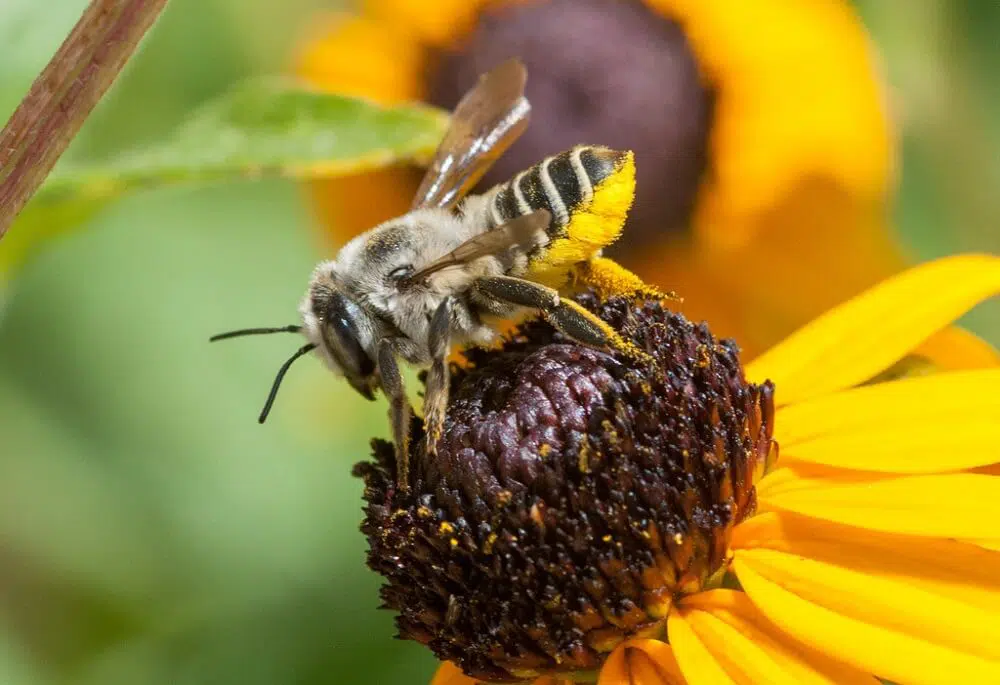
The Megachile Parallela grows to 14mm in females and 13mm in males. These bees have dark hairs and are common in Texas. They are more common from June to September when they feed off flowers.
These bees are great pollinators, known to be non-aggressive, though they will sting if they feel threatened or are provoked.
24. Honey-tailed Striped Sweat Bee
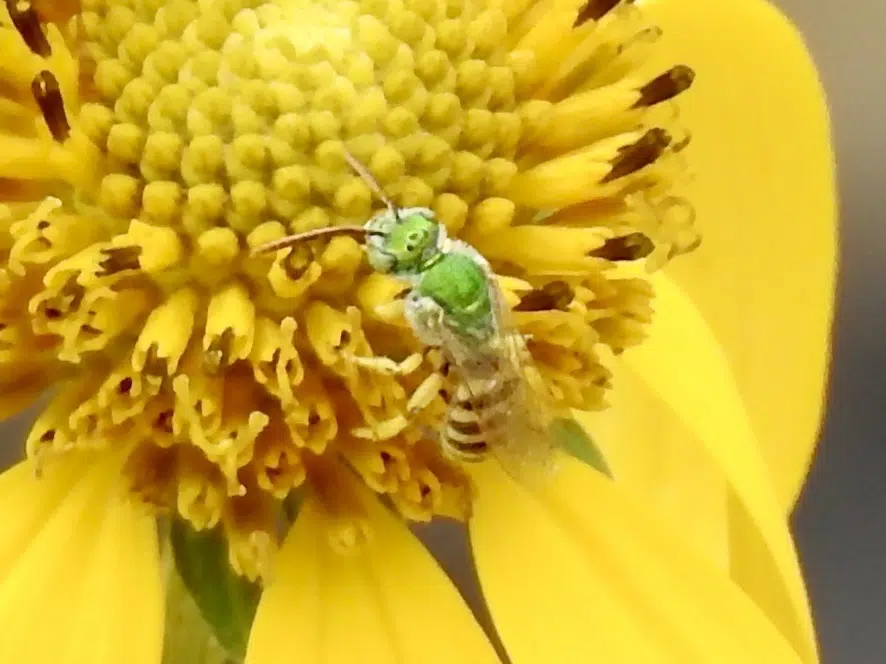
Honey-tailed Striped Sweat Bees (Agapostemon melliventris) are the name that best describes the female. Males have a striped black and yellow abdomen, while females have a golden honey color with almost white stripes.
Both the males and females have a green thorax and head. They are solitary best that tend to nest underground. The nests are randomly scattered and not easy to find. These bees are more common in Texas and California.
25. Texas Striped Sweat Bee

The Texas Striped Sweat Bee (Agapostemon texanus) is a common bee in North America, which varies greatly in appearance. These bees vary in color, along with the amount of black on their legs.
The female Texas striped sweat bee can grow to 11mm in body length, while the male grows to 10mm. They are more common from April through to November when they visit flowers.
26. Western Carpenter
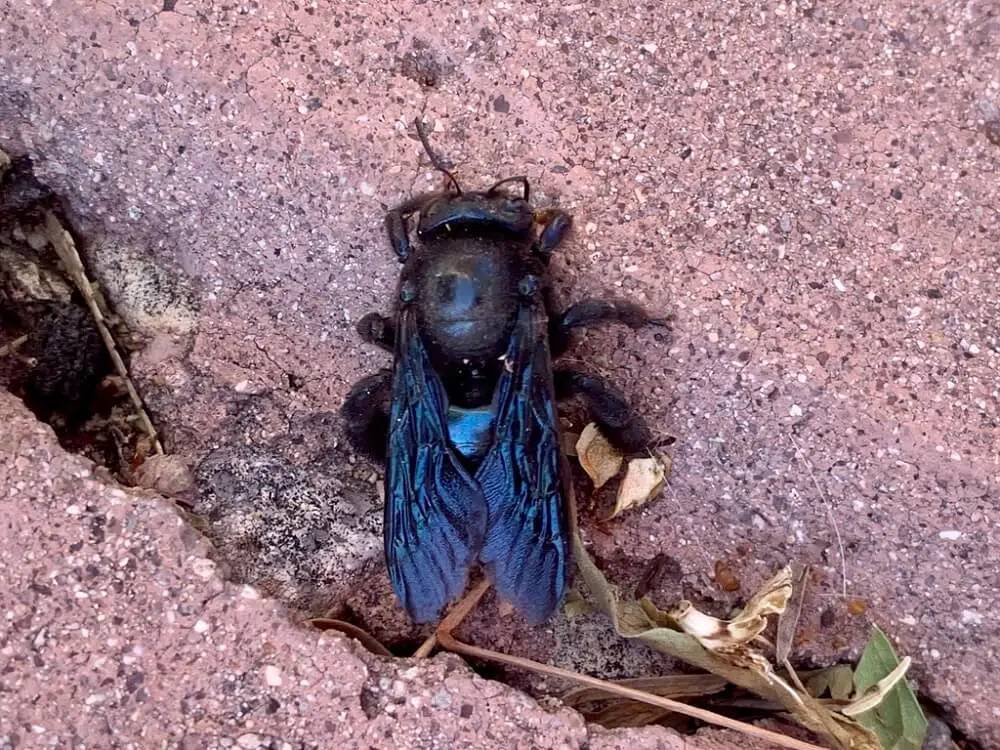
Western Carpenters (Xylocopa californica) are all black bees with a blue to green colored reflection. Males have some hairs on the pronotum and abdominal segments. These are large bees growing to 25mm in body length.
These bees may be encountered in meadows and forests in Texas, where they are more common in late summer.
27. Pure Green-Sweat Bee

The Pure Green-Sweat Bee (Augochlora pura) is a solitary bee, common in the eastern United States. They are bright green and forage in a range of plants. These bees live in rotting logs, producing three generations per year.
Males and females are around the same size, which is approximately 8mm in length. They have a shiny bright green body with darker mandibles. Mandibles may appear blue in females.
These bees are mostly active from February to November. They seldom travel far from their nests.
28. Texas Nomad Bee
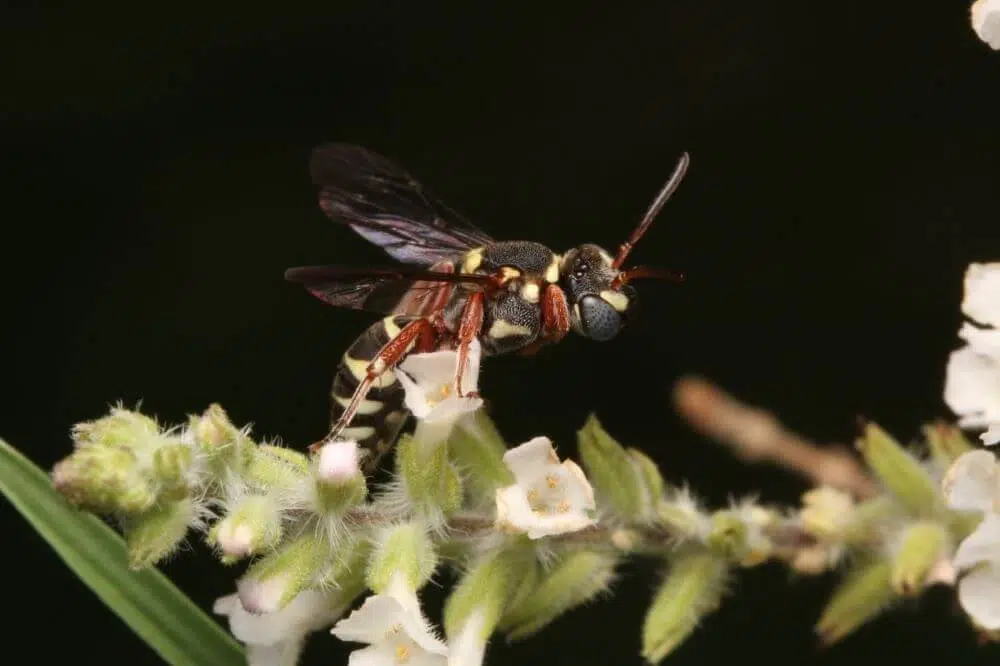
The Texas Nomad Bee (Nomada texana) is a wasp-looking bee with a sleek body and well-defined stripes. They are usually black, yellow, or red, sometimes a combination of the three. These bees are mostly encountered in Texas with black or red bodies, yellow markings, red or yellow legs, and red to brown colored antennae.
Most of the Texas nomad bees have black bodies, red legs, and yellow stripes on their abdomens. There are also yellow spots on the thorax and they have a yellow mask on their faces.
Females can grow to 9mm with males being slightly larger at 10mm.
29. Hibiscus Turret Bee
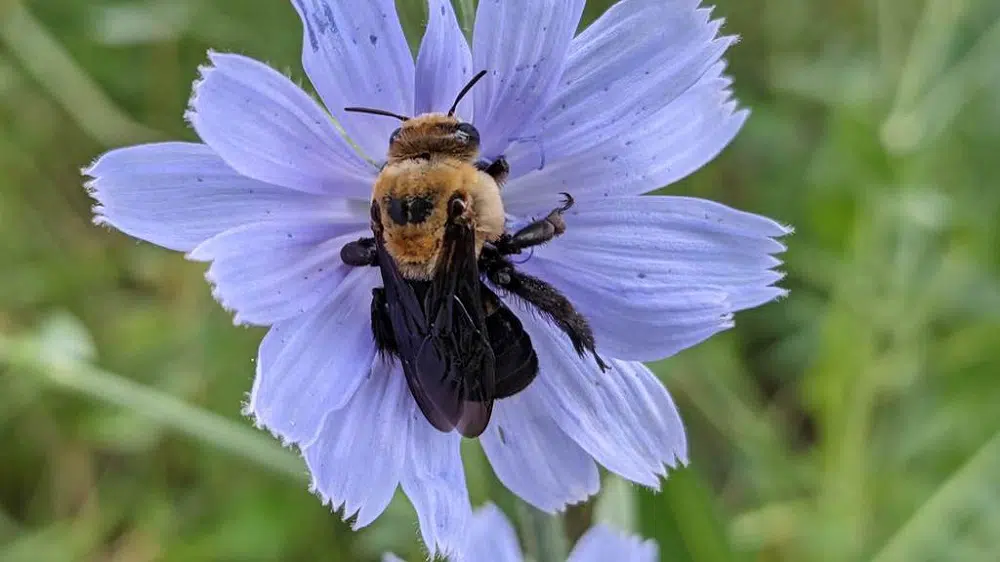
The Hibiscus Turret Bee (Ptilothrix bombiformis) can grow to 15mm in body length. They are solitary bees that build their nests underground, which means they are very difficult to find. They are more common from June to August, where they feed on the pollen and nectar of Hibiscus flowers.
These bees look very similar to bumblebees. They are robust and fast flying with yellow hairs on their thorax. Females dig their nets in hard-packed soil near to water.
30. Lunate Longhorn-Cuckoo

The Lunate Longhorn-Cuckoo (Triepeolus lunatus) belongs to the Apidae family, where they live in forests and meadows. These bees are mostly active in the summer and fall, where they feed on flower nectar.
This bee species can grow to half an inch in length and are similar in appearance to a wasp. They have a black abdomen and thorax, which have white markings. They have short hairs on their body and two white stripes on their thorax.
31. Southern Plains Bumble Bee

The Southern Plains Bumble Bee (Bombus fraternus) is an endangered species and native to the United States. This bumblebee is mostly black with yellow banding on the abdomen and thorax. They are larger than other bumblebees with queens reaching 27mm in body length and workers around 19mm in body length.
The appearance of the queen and workers are very similar. Females have black and yellow hairs covering their body with black hairs on the face and side of the thorax. Males have larger eyes and longer antennae.
32. Blueberry Digger Bee
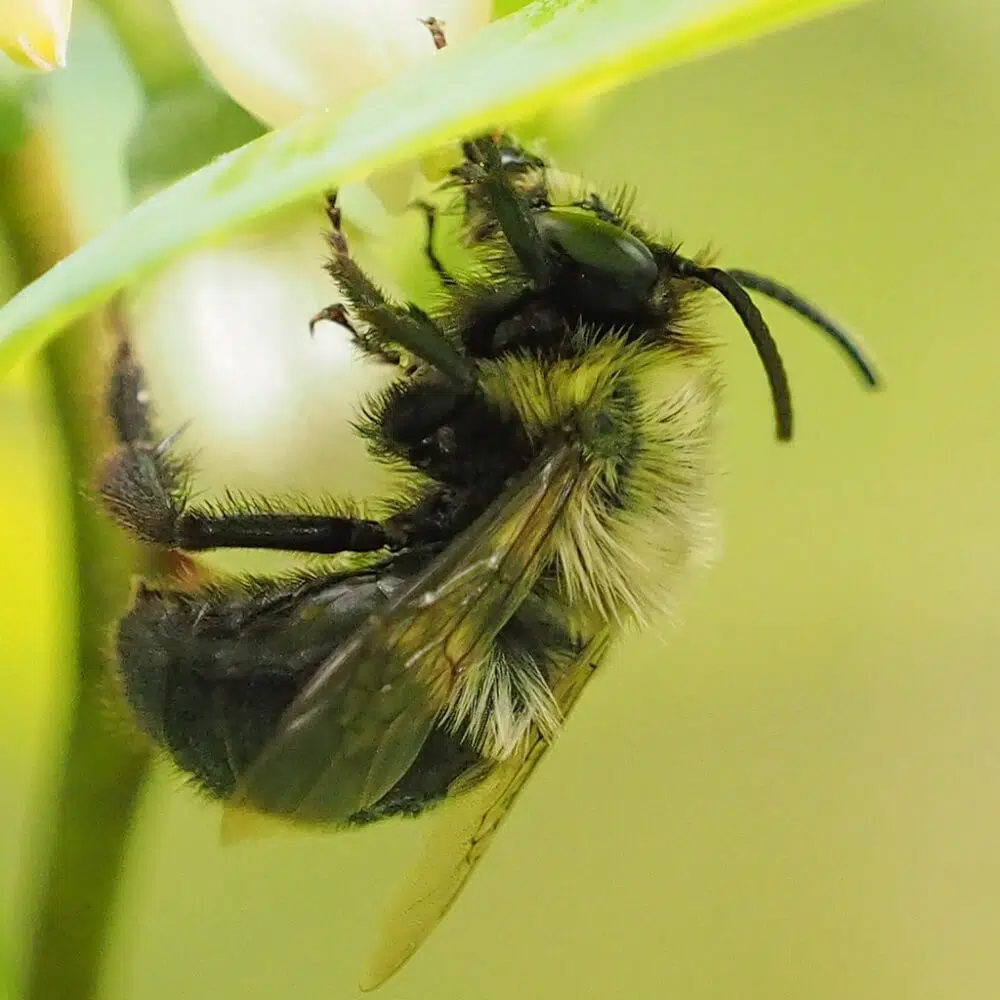
Blueberry Digger Bees (Habropoda laboriosa) are active from February to April, foraging primarily on blueberries. They emerge just before flowering, which improves yields. These bees look like small bumblebees.
They are strong fliers and can grow up to 16mm in females and 14mm in males.
33. Norton’s Nomia

Norton’s Nornia (Nomia nortoni) are large-sized bees with females growing to 16mm and males to 22mm in body length. They are distinctively marked and large in size, making them easy to identify. They have green banding on their abdomens.
These bees are more common from July to November where they are seen taking pollen from a variety of flowers including sunflowers.
34. Hoary Leaf Cutter Bee
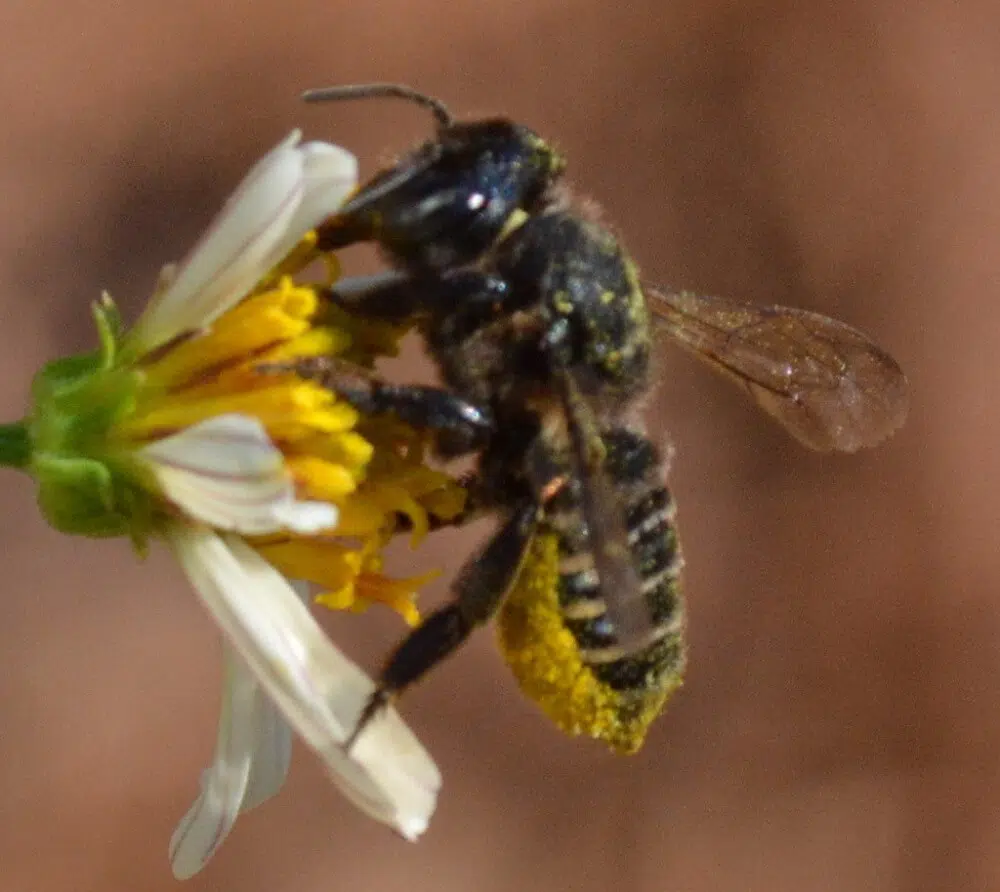
Hoary Leaf Cutter Bees (Megachile pruina) are solitary and do not live in a community nest. Each female is responsible for building and provisioning her own nest. These are black bees with white banding on their abdomen.
Their wings are dark and transparent and some have white masks on their face. Some have a white border around their thorax.
35. Anthophora abrupta
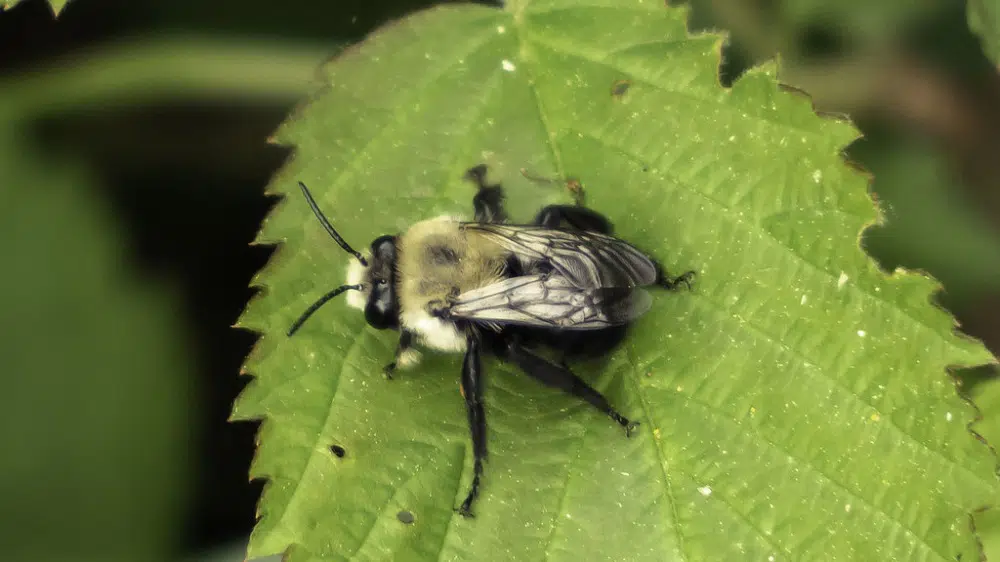
This bee is also known as a miner or chimney bee. It is a solitary ground-nesting bee. They are not aggressive and seldom sting. They will bite if they need to defend themselves.
They are excellent pollinators for a variety of flowers and are not timid when it comes to human interactions. They look like fast and small bumblebees. Their abdomen, legs, and heads are covered in brown/black hairs, while the thorax has dense yellow/orange hairs.
Females grow to around 17mm in body length; males are similar in size. The males have hairs on the margin of their yellow clypeus, making them look as though they have a yellow mustachio.
36. Curved Pebble Bee

Curved Pebble Bees (Dianthidium curvatum) are small bees, growing to around 7mm in body length. They are widely distributed and most common from April to October.
These are yellow and black bees with dark vein wings. They have a yellow mask and yellow on their legs.
37. Dieunomia heteropoda

This bee is a sweat bee species, common in Central and North America. These bees are known for licking perspiration from humans, it is believed they are attracted to the salt on the skin.
These bees are completely black, from their thorax to their abdomens, wings, and legs. Their antennae are short.
38. Megachile inimica

The Megachile inimica is also known as the hostile leafcutter bee. It has white hair bands on the abdomen. These solitary bees are responsible for building and provisioning their own nests, often covering them with leaf litter and covering the entrance with a leaf.
They are black with white banding on the abdomen. Their thorax, head, and antennae are all black. Wings are transparent black with visible veins.
Further Reading: